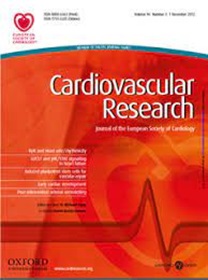Proteomic profiling reveals a higher presence of glycolytic enzymes in human atherosclerotic lesions with unfavourable histological characteristics
IF 13.3
1区 医学
Q1 CARDIAC & CARDIOVASCULAR SYSTEMS
引用次数: 0
Abstract
Aims Molecular characterization of vulnerable atherosclerotic plaques often relies on transcriptomic data. However, RNA expression may not consistently align with protein expression. The proteomic landscape linked to plaque vulnerability is underexplored in human lesions. In this study, we analyzed a large mass spectrometry-based proteomics dataset from the plaque tissue of 320 patients to identify the molecular mechanisms associated with vulnerable plaques. Previous studies have shown significant differences in cell metabolism in murine atherosclerosis models, prompting an in-depth description of expression of key enzymes in glycolysis in human atherosclerotic plaques. Methods and results Atherosclerotic lesions from 320 patients undergoing carotid endarterectomy surgery were collected (200 discovery set and 120 for the validation set) and underwent proteomic analyses. Plaque samples were digested, enriched for extracellular matrix proteins, and processed for untargeted proteomics analysis. The resulting protein levels were linked to pathological plaque characteristics, bulk and single cell transcriptomics, and clinical data. Proteomic analysis of 200 human atherosclerotic carotid lesions detected 1499 proteins with most showing poor correlation with RNA levels. We identified 240 proteins associated with plaque vulnerability index (PVI) (FDR<0.05), including key glycolysis enzymes: HK3 (P=0.003, FDR=0.03), PKM (P=0.008, FDR=0.05), and LDHA (P=0.006, FDR=0.04). The observed associations were mainly driven by macrophage content and fat content, reflected the severity of pre-operative symptoms, exhibited significant sex differences, and correlated with plaque haemorrhage biomarker BLVRB. Validation in 120 patients confirmed HK3 and PKM's association with plaque progression and clinical symptoms (all P<0.001). Conclusion Enzymes involved in the glycolysis process are more abundant in plaques with vulnerable histological characteristics and are significantly associated with plaque hemorrhage biomarker BLVRB. This implies that plaque destabilization may be driven by higher glycolysis metabolism, which may contribute to plaque haemorrhage. This association was stronger in women, underlining the important role of energy metabolism in sex-specific mechanisms of atherosclerotic disease.蛋白质组学分析显示,糖酵解酶在人类动脉粥样硬化病变具有不利的组织学特征较高的存在
目的易损性动脉粥样硬化斑块的分子特征通常依赖于转录组学数据。然而,RNA表达可能与蛋白质表达不一致。与斑块易损性相关的蛋白质组学景观在人类病变中尚未得到充分探索。在这项研究中,我们分析了来自320名患者斑块组织的基于质谱的大型蛋白质组学数据集,以确定易损斑块相关的分子机制。先前的研究表明小鼠动脉粥样硬化模型中细胞代谢存在显著差异,促使人们对人类动脉粥样硬化斑块中糖酵解关键酶的表达进行深入描述。方法与结果收集320例颈动脉内膜切除术患者的动脉粥样硬化病变(发现组200例,验证组120例),进行蛋白质组学分析。对斑块样品进行消化,富集细胞外基质蛋白,并进行非靶向蛋白质组学分析。由此产生的蛋白质水平与病理斑块特征、大块和单细胞转录组学以及临床数据有关。对200例人颈动脉粥样硬化病变的蛋白质组学分析发现了1499种蛋白质,其中大多数与RNA水平相关性较差。我们鉴定出240种与斑块易损指数(PVI)相关的蛋白(FDR<0.05),包括关键的糖酵解酶:HK3 (P=0.003, FDR=0.03)、PKM (P=0.008, FDR=0.05)和LDHA (P=0.006, FDR=0.04)。所观察到的相关性主要由巨噬细胞含量和脂肪含量驱动,反映了术前症状的严重程度,表现出显著的性别差异,并与斑块出血生物标志物BLVRB相关。120例患者的验证证实HK3和PKM与斑块进展和临床症状相关(所有P&;lt;0.001)。结论参与糖酵解过程的酶在斑块中更为丰富,具有易损的组织学特征,且与斑块出血生物标志物BLVRB显著相关。这意味着斑块不稳定可能是由更高的糖酵解代谢驱动的,这可能导致斑块出血。这种关联在女性中更强,强调了能量代谢在动脉粥样硬化疾病的性别特异性机制中的重要作用。
本文章由计算机程序翻译,如有差异,请以英文原文为准。
求助全文
约1分钟内获得全文
求助全文
来源期刊

Cardiovascular Research
医学-心血管系统
CiteScore
21.50
自引率
3.70%
发文量
547
审稿时长
1 months
期刊介绍:
Cardiovascular Research
Journal Overview:
International journal of the European Society of Cardiology
Focuses on basic and translational research in cardiology and cardiovascular biology
Aims to enhance insight into cardiovascular disease mechanisms and innovation prospects
Submission Criteria:
Welcomes papers covering molecular, sub-cellular, cellular, organ, and organism levels
Accepts clinical proof-of-concept and translational studies
Manuscripts expected to provide significant contribution to cardiovascular biology and diseases
 求助内容:
求助内容: 应助结果提醒方式:
应助结果提醒方式:


